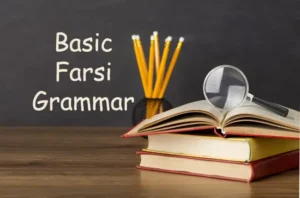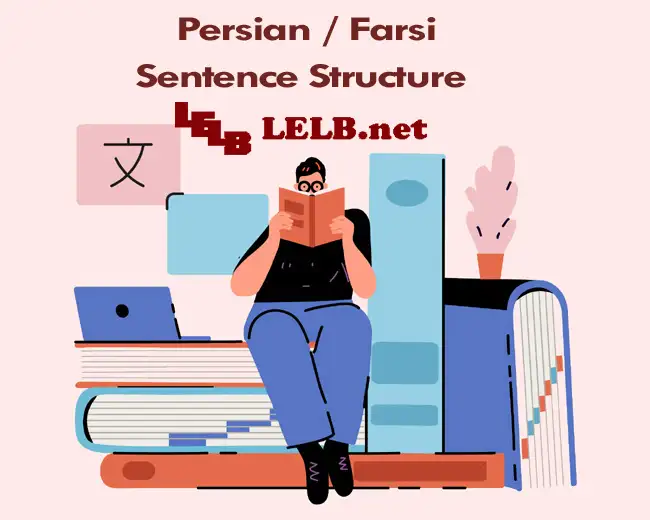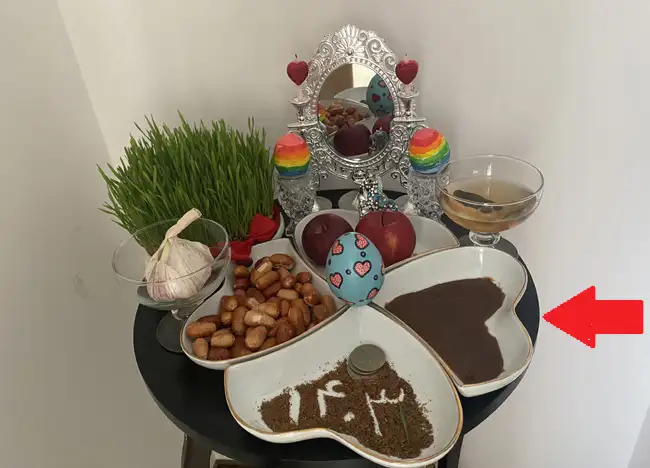Persian sentence structure and syntax for non-Persian speakers with a video and simple explanations. Make correct sentences in Farsi and improve your Persian grammar if you like to learn Farsi accurately.
Video of Persian sentence structure
Persian sentence structure

Persian sentence structure is different from English sentence structure and formation. This is partly because Persian verbs are more conjugational and inflectional compared to English verbs. For this reasons, it is not always necessary to mention the subject or subject pronoun in Persian sentences because the subject could be implied. For instance, consider the following sentence in Farsi:
(من) غذا را خوردم.
I ate the food.
Unlike English, in Farsi, the Persian pronoun من could be omitted because it is understood from م-َ in خوردم.
One marked difference between Persian and English sentence structures is word order in Persian grammar and syntax.
Word order in Persian sentences

Farsi uses subject-object-verb (SOV) word order, unlike English which follows subject-verb-object (SVO) order. Objects are only present in sentences with transitive verbs or افعال گذرا, and not all sentences require an object. Please pay attention to the following examples:
English: I watched the film.
Persian: من فیلم را دیدم = I the film watched.
Subjects in Persian sentences
Standard Persian sentences start with subjects or subject pronouns:
آموزش زبان فارسی آسان است.
Learning Persian is easy.
In the above sentence, آموزش زبان فارسی is the subject, which is located at the start of the sentence. As you can see, in this case, the subject is not one single word, but a noun phrase or عبارت اسمی that is a combination of some Persian words.
Spring is a beautiful season.
In the previous example, بهار or spring is the subject of the sentence, which is located at the beginning of the sentence.
Objects in Persian sentences
In Persian grammar, objects are located between subjects and verbs. As mentioned earlier, objects only appear in sentences with transitive verbs, like the following:
بچه ها داستان کوتاه را خواندند.
The children read the short story.
در جلسه شرکت، گوشی تلفن همراه خود را سایلنت کردم.
During the company meeting, I silenced my cell phone.
The function of “ra / را” in transitive verbs

In the Persian language, most of the time, you need to use “ra / را” after the object in transitive verbs. For instance:
من ماشین را شستم.
I washed the car.
You can study the following Persian lesson on the function of “ra / را” in transitive verbs:
In spoken Farsi, “ra:” changes to “ro” or “o” for ease of pronunciation. Sometimes, “ra:” is even left out:
بیتا کتاب رو برداشت.
Bita picked up the book. (ra: changes to ro)
مامان رمانو خوند.
Mom read the novel. (ra: changes to o.)
بابا از رستوران چند ساندویچ خرید.
Daddy bought some sandwiches from the restaurant. (ra: is omitted.)
Verbs in Persian sentences

Verbs in the Persian language are more complex than English verbs. This is because for each Persian verb, you need to know both past and present roots. These roots or بن فعل are accompanied by inflectional prefixes and suffixes to account for Persian tenses and agents or pronouns. For instance, consider the verb رفتن which means to go:
- The past root of رفتن is رفت
- The present root of رفتن is رو
- The infinitive is رفتن
- I went = من رفتم
- I go = من می روم
- I will go = من خواهم رفت
The location of Persian verbs
It’s important to note that in standard Farsi sentences, verbs are always located at the end of sentences. This rule even applies to Persian sentences in question or interrogative forms. For example:
آیا برای آخر هفته، وقت آزاد داری؟
Are you free / do you have free time on the weekend?
من تنهایی به کوه نمی روم.
I don’t go mountain climbing all alone.
In the above example, نمی روم is a negative verb in Farsi in simple present tense or زمان حال ساده.. As you can see, even in negative sentences, Farsi verbs are always located at the end of sentences.
Complements in Persian sentences
A complement or متمم is a noun or noun phrase that comes after a preposition in order to complete the meaning of the sentence in which it is used. For example:
من به مدرسه می روم.
I go to school.
In the above example, به is a preposition or حرف اضافه and school or مدرسه is the complement. As it is clear, the location of complements in Farsi sentences is like objects, i.e. between subjects and verbs. Now, let’s review some other examples:
ما از مهمان ها پذیرایی کردیم.
We served the guests.
In the previous sentence, از (from) is the preposition and مهمان ها (the guests) is the complement. It’s important to note that in this example, مهمان ها could semantically and logically be regarded as the object, although we don’t use “را” to label the verb “transitive”.
دوست من روی صندلی نشست و استراحت کرد.
My friend sat on the chair and took some rest.
In the previous example, روی means “on” which is a preposition, and صندلی (chair) is the complement.
Adverbs in Persian sentences

Adverbs in the Persian language are generally located after the subject. However, in the English language, adverbs often appear at the end of sentences, except for adverbs of time like always, never, usually, etc. For instance:
پدرم با احتیاط رانندگی می کند.
My father drives carefully.
همسر من همیشه غذای خوشمزه درست می کند.
My spouse (wife or husband) always cooks delicious food.
Put your knowledge into practice

Now that you’ve learned the ABCs of the Persian sentence structure, it’s high time you made some simple sentences of your own in Farsi in the comment box below. We will analyze all of your comments and give you professional feedback immediately.



